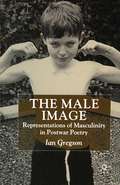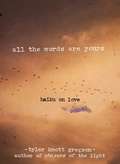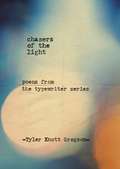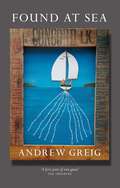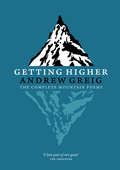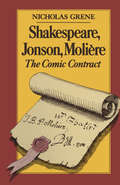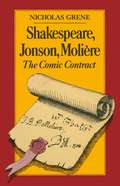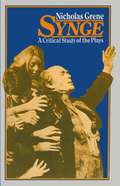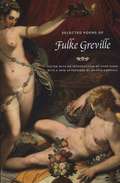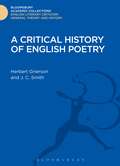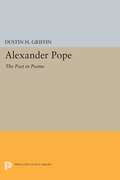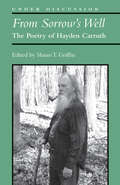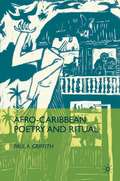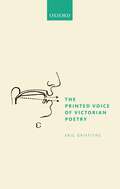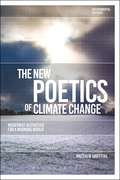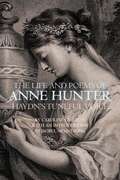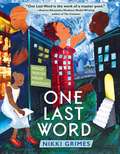- Table View
- List View
The Male Image: Representations of Masculinity in Postwar Poetry
by Ian GregsonThis book discusses how masculinity is represented by women poets and gay poets - but, most of all, how it is represented by straight male poets. It shows how Robert Lowell and John Berryman both identify a gender malaise in themselves which they struggle with throughout their careers, and how Derek Walcott displays a profound gender insecurity in relation to the colonial experience. It discusses the impact on Ted Hughes and Seamus Heaney of their belief in a transcendent feminine principle, and how C.K. Williams and Paul Muldoon display the impact of feminism on male poets who are young enough to have encountered it at a formative period.
All the Words Are Yours: Haiku On Love
by Tyler Knott GregsonI'll be your deep breath,I'll be your simple relief.I'll be home to you.Every day for the past six years, Tyler Knott Gregson has written a simple haiku about love and posted it online. These heartfelt poems have spoken to readers around the world, and won Tyler a large and loyal following. Now, in All the Words Are Yours - the follow-up to the US bestseller Chasers of the Light - this startlingly honest, vulnerable and moving new voice presents his favourites among those haiku. Some are previously unpublished; all are accompanied by his signature photographs, reproduced in gorgeous full colour. Together, they capture the textures of daily life and extraordinary love through the eyes of a man truly present in each moment.
Chasers of the Light: Poems From The Typewriter Series
by Tyler Knott GregsonI would love to say that you make me weak at the knees, but to be quite upfront and completely truthful, you make my body forget it has knees at all.One day, while browsing an antique store in Helena, Montana, photographer Tyler Knott Gregson stumbled upon a vintage Remington typewriter for sale. Standing up and using a page from a broken book he was buying for $2, he typed a poem without thinking, without planning, and without the ability to revise anything.He fell in love.Three years and almost one thousand poems later, Tyler is now known as the creator of the Typewriter Series: a striking collection of poems typed onto found scraps of paper or created via blackout method.Chasers of the Light features some of his most insightful and beautifully worded pieces of work-poems that illuminate grand gestures and small glimpses, poems that celebrate the beauty of a life spent chasing the light.
Found at Sea
by Andrew GreigAndrew Greig recounts in poetic sequence the tale of his open dinghy voyage from Stromness in Scapa Flow and an overnight stay on Cava (an island formerly inhabited for over twenty years by two unusual women) in poetic sequence. In sailing small boats in scary open waters Andrew Greg found a new activity and a new metaphor for life. Written in six weeks, Found at Sea is a 'very wee epic' about sailing, male friendship and a voyage. Bon voyage!
Getting Higher: The Complete Mountain Poems
by Andrew GreigAndrew Greig is a Scottish poet of sensitivity and resilience. He deals with high-risk situations - from mountaineering to love - and is particularly good at presenting the gamut of feelings involved in rites of passage: high endeavour, commitment, holding back, drift, release' - Edwin Morgan 'A writer of integrity and imaginative energy' - TLS 'A lyric poet of rare gusto' - The Observer Alongside the mountain poems from Men on Ice, Order of the Day and Western Swing, Getting Higher features brand new material, facsimiles of previously unpublished material - including his first poem, written in 1972 - and illustrations and material from the National Library of Scotland archive. A beautiful collector's item full of illustrations, marginalia and notes.
Shakespeare's Tragic Imagination
by Nicholas GreneThe world of Macbeth, with its absolutes of good and evil, seems very remote from the shifting perspectives of Antony and Cleopatra, or the psychological and political realities of Coriolanus. Yet all three plays share similar thematic concerns and preoccupations: the relation of power to legitimating authority, for instance, or of male and female roles in the imagination of (male) heroic endeavour. In this acclaimed study, Nicholas Grene shows how all nine plays written in Shakespeare's main tragic period display this combination of strikingly different milieu balanced by thematic interrelationships. Taking the English history play as his starting point, he argues that Shakespeare established two different modes of imagining: the one mythic and visionary, the other sceptical and analytic. In the tragic plays that followed, themes and situations are dramatised, alternately, in sacred and secular worlds. A chapter is devoted to each tragedy, but with a continuing awareness of companion plays: the analysis of Julius Caesar informing that of Hamlet, discussion of Troilus and Cressida counterpointed by the critique of Othello and the treatment of King Lear growing out from the limitations of Timon of Athens. The aim is to resist homogenising the plays but to recognise and explore the unique imaginative enterprise from which they arose.
The Selected Poems of Fulke Greville
by Fulke GrevilleAlong with his childhood friend Sir Philip Sidney, Fulke Greville (1554–1628) was an important member of the court of Queen Elizabeth I. Although his poems, long out of print, are today less well known than those of Sidney, Spenser, or Shakespeare, Greville left an indelible mark on the world of Renaissance poetry, both in his love poems, which ably work within the English Petrarchan tradition, and in his religious meditations, which, along with the work of Donne and Herbert, stand as a highpoint of early Protestant poetics. Back in print for a new generation of scholars and readers, Thom Gunn’s selection of Greville’s short poems includes the whole of Greville’s lyric sequence, Caelica, along with choruses from some of Greville’s verse dramas. Gunn’s introduction places Greville’s thought in historical context and in relation to the existential anxieties that came to preoccupy writers in the twentieth century. It is as revealing about Gunn himself, and the reading of earlier English verse in the 1960s, as it is about Greville’s own poetic achievement. This reissue of Selected Poems of Fulke Greville is an event of the first order both for students of early British literature and for readers of Thom Gunn and English poetry generally.
A Critical History of English Poetry (Bloomsbury Academic Collections: English Literary Criticism)
by Herbert Grierson J. C. SmithThis famous work was the result of the wartime collaboration of two Scottish scholars. Their tracing of the course of English poetry has been described by The Times Literary Supplement as a 'volume of masterly compression'. They deliberately spend most time on the greatest poets, believing that, significant as traditions and influences are, the great poet himself affects the spirit of his age and moulds the tradition he has inherited. At the same time, enough attention is paid to minor poets to make the book historically complete, and to fill in the most important links in the chain of poetic development. Thus Gower is here, as well as Chaucer; Patmore, as well as Browning. Both in scope and in detail A Critical History of English Poetry is a distinguished and valuable work.
Alexander Pope: The Poet in Poems (PDF)
by Dustin H. GriffinWhat is the precise relation between the "Pope" of the poems and the Pope of history? Seeking to clarify the nature of the intimate link between the historical self and the idealized self of the poetry, Dustin Griffin examines the various ways in which Pope's poems may be said to be self-expressive. He brings a sensitive critical reading of the texts and an impressive knowledge of the poet's life and writings to his discussion of poems from the entire range of the poet's career. The author argues that Pope is present in his poems as a private person whose special imaginative and psychological concerns emerge because they are expressed publicly. In some poems, Pope confronts quite openly his fervent moral idealism with his powerful aggressive feelings, and he explores his conflicting impulses toward retirement and engagement. In others, he reveals impulses and attractions that he would not admit to full consciousness in his letters. Pope is also present as poet-protagonist, self-consciously attempting to present and master a body of poetic material. Professor Griffin's study recovers some of the personal energy that invigorates Pope's greatest poems and makes them strikingly self-expressive products of an imagination intrigued and often at odds with itself and, yet more sharply, with the world.Originally published in 1979.The Princeton Legacy Library uses the latest print-on-demand technology to again make available previously out-of-print books from the distinguished backlist of Princeton University Press. These editions preserve the original texts of these important books while presenting them in durable paperback and hardcover editions. The goal of the Princeton Legacy Library is to vastly increase access to the rich scholarly heritage found in the thousands of books published by Princeton University Press since its founding in 1905.
From Sorrow's Well: The Poetry of Hayden Carruth (Under Discussion)
by Shaun T GriffinHayden Carruth survived isolation, mental health problems, and long struggle with drink and smoke to produce a vision of modern poetry rooted in the New England tradition but entirely his own. Many feel his best poems emerged from the isolation of rural Vermont, and his poems often are concerned with rural images and metaphors reflecting the land and hardscrabble people around him. Together with his second love, jazz, Carruth’s rural experiences infuse his poems with engaging and provocative ideas even as they present sometimes stark topics. This volume collects essays and poems from such notable contributors as Donald Hall, Marilyn Hacker, Adrienne Rich, Philip Booth, Matthew Miller, and Sascha Feinstein, among many others. The book’s sections concern the kinds of writings, and the values expressed in his writings, for which Carruth was most famous, including what editor Shaun T. Griffin calls “social utility,” jazz, his impoverished rural environment, and “innovation” in poetic form.
Long Shadow: Emily Dickinson's Tragic Poetry
by Clark GriffithClark Griffith seeks to demonstrate that, if we come to terms with her true intellectual position, we find that Emily Dickinson is a tragic poet. He studies her special connection with the Age of Emerson, her dependence upon irony, her change in attitude from detachment to tragic involvement.Originally published in 1964.The Princeton Legacy Library uses the latest print-on-demand technology to again make available previously out-of-print books from the distinguished backlist of Princeton University Press. These editions preserve the original texts of these important books while presenting them in durable paperback and hardcover editions. The goal of the Princeton Legacy Library is to vastly increase access to the rich scholarly heritage found in the thousands of books published by Princeton University Press since its founding in 1905.
Afro-Caribbean Poetry and Ritual
by P. GriffithFocusing on orally transmitted cultural forms in the Caribbean, this book reaffirms the importance of myth and symbol in folk consciousness as a mode of imaginative conceptualization. Paul A. Griffith cross-references Kamau Brathwaite and Derek Walcott s postcolonial debates with issues at seminal sites where Caribbean imaginary insurgencies took root. This book demonstrates the ways residually oral forms distilled history, society, and culture to cleverly resist aggressions authored through colonialist presumptions. In an analysis of the archetypal patterns in the oral tradition - both literary and nonliterary, this impressive book gives insight into the way in which people think about the world and represent themselves in it.
The Printed Voice of Victorian Poetry
by Eric GriffithsThe Printed Voice of Victorian Poetry starts from a simple fact: our written language does not represent the way we speak. Intonation, accent, tempo, and pitch of utterance can be inferred from a written text but they are not clearly demonstrated there. The book shows the implications of this fact for linguists and philosophers of language and offers fundamental criticisms of some recent work in these fields. It aims principally to describe the ways in which nineteenth-century English poets–Tennyson, Browning, Hopkins–responded creatively to the ambiguities involved in writing down their own voices, the melodies of their speech. Original readings of the poets' work are given, both at a minutely detailed level and with regard to major preoccupations of the period–immortality, morbidity, marriage, social divisions, and religious conversions–and in this way Eric Griffiths offers a new map of Victorian poetry.
The Printed Voice of Victorian Poetry
by Eric GriffithsThe Printed Voice of Victorian Poetry starts from a simple fact: our written language does not represent the way we speak. Intonation, accent, tempo, and pitch of utterance can be inferred from a written text but they are not clearly demonstrated there. The book shows the implications of this fact for linguists and philosophers of language and offers fundamental criticisms of some recent work in these fields. It aims principally to describe the ways in which nineteenth-century English poets–Tennyson, Browning, Hopkins–responded creatively to the ambiguities involved in writing down their own voices, the melodies of their speech. Original readings of the poets' work are given, both at a minutely detailed level and with regard to major preoccupations of the period–immortality, morbidity, marriage, social divisions, and religious conversions–and in this way Eric Griffiths offers a new map of Victorian poetry.
A Love Letter from a Stray Moon (Penguin Specials)
by Jay GriffithsI am Frida but also I am not Frida. I am her paintings and the nature of her love. I am her shadow. I am many women, I answer to many names, any who knows grief. I am all the phases of the moon, I am all her qualities. I am El Duende, I am the light of the psyche, writing from my soul, speaking to the psyche of humanity, the psyche which is shaped like the wings of a butterfly or a moth; fly closer, fly nearer to me. A Love Letter from a Stray Moon is a fictionalised portrait of the intense and prolific life of Frida Kahlo. In beautifully lyrical language, Jay Griffiths explores the artist's childhood polio, her devastating accident and her turbulent relationship with Diego Rivera, painting a vivid and unique picture of passion, grief and transcendence.Set against the backdrop of revolutionary Mexico, A Love Letter from a Stray Moon is partly a poetic depiction of a woman in flight from the hollowness of childlessness, the burning of betrayal and the constraints of physical pain. It is also a celebration of rebellion - from Frida's own politics to the present-day Zapatistas - and a hymn to the revolutionary fire at the heart of art.'A wonderful book. It's like a dress that Kahlo invented for herself and wore' John Berger'A rich and extraordinary vision. Jay Griffiths is a fearless adventurer with words and images. I salute her courage and the splendour of this vision' Philip Pullman'An extraordinarily beautiful and sustained prose poem, a call for engagement with the world, and a powerful and astonishing feat of literary and retroactive telepathy. It is a book about possession, in many forms, each of which is sparked by a particular urgency: to comprehend, to celebrate and to endure' Niall Griffiths'Frida Kahlo's life and work were indivisible, and with a power worthy of her subject Jay Griffiths has found a way of writing Kahlo's broken, prolific life. Through Griffiths we hear the voice of Frida Kahlo herself, as if she were speaking directly to us. I devoured this wonderfully perceptive and sensitive book' Marie Darrieussecq'A stunning allegory about love, art and revolution. She makes every word, every scene, in this passionate narrative count. It's brilliant work' Barry Lopez'Vivid as a bloom in the jungle, visionary as a flight over a desert, a love song to life on earth' Joan London'A love letter to human originality' Melanie Challenger'I found in Griffiths's writing a crafted freedom that feels made from the mist of dreams and a very real emerging dawn. Imagine being held in the open hand of moonlight and carried through a dream into day. This is what it is like to read A Love Letter from a Stray Moon. It is a book for men to read on women and for women to read on men. I am transported and transformed; I feel lucky to have read it and it leaves me in awe' Lemn SissayJay Griffiths is the author of Pip Pip: A Sideways Look at Time and Wild: An Elemental Journey. She is the winner of the inaugural Orion Book Award and of the Barnes & Noble DiscoverAward for the best new non-fiction writer to be published in the USA. She has also been shortlisted for the Orwell Prize and a World Book Day award.
The New Poetics of Climate Change: Modernist Aesthetics for a Warming World (Environmental Cultures)
by Matthew GriffithsClimate change is the greatest issue of our time – and yet too often literature on the subject is considered only in the bracket of 'environmental' writing, divorced from culture, society and politics. The New Poetics of Climate Change argues instead that the emergence of global warming presents a fundamental challenge to the way we read and write poetry – the way we think – in the modern age.In this important new book, Matthew Griffiths demonstrates that Modernism's radical reinvigorations of literary form over the last century represent an engagement with key intellectual questions that we still need to address if we are to comprehend the scale and complexity of climate change. Through an extended examination of Modernist poetry, including the work of T. S. Eliot, Wallace Stevens, Basil Bunting and David Jones, and their influence on present-day poets including Jorie Graham, Griffiths explores how Modernist modes can help us describe and engage with the terrifying dynamics of a warming world and offer a poetics of our climate.
The New Poetics of Climate Change: Modernist Aesthetics for a Warming World (Environmental Cultures)
by Matthew GriffithsClimate change is the greatest issue of our time – and yet too often literature on the subject is considered only in the bracket of 'environmental' writing, divorced from culture, society and politics. The New Poetics of Climate Change argues instead that the emergence of global warming presents a fundamental challenge to the way we read and write poetry – the way we think – in the modern age.In this important new book, Matthew Griffiths demonstrates that Modernism's radical reinvigorations of literary form over the last century represent an engagement with key intellectual questions that we still need to address if we are to comprehend the scale and complexity of climate change. Through an extended examination of Modernist poetry, including the work of T. S. Eliot, Wallace Stevens, Basil Bunting and David Jones, and their influence on present-day poets including Jorie Graham, Griffiths explores how Modernist modes can help us describe and engage with the terrifying dynamics of a warming world and offer a poetics of our climate.
Rediscovering Rubén Darío through Translation
by Dr. Carlos F. GrigsbyA long overdue examination of Rubén Darío's multilingual work and influences alongside the contexts and politics of canonization in world literature. Rediscovering Rubén Darío through Translation addresses the peculiar obscurity of Darío by asking these questions: How can one of the most important writers of a major world language be almost entirely unknown in the English-speaking world? How is it that other writers of the same language (e.g., Lorca or García Márquez) achieve widespread recognition in the anglophone world, while he remains unnoticed? What role does translation play in this? What can it tell us about the way in which world literature is articulated? Carlos F. Grigsby approaches Darío's oeuvre through translation. In doing so, he explores not only the place of Darío in the translation of Spanish American literature into English, but also the place of translation in Darío's own writing. The result is a double-sided painting, as it were: the recto is titled “Translation in Darío” and the verso “Darío in Translation.” This book challenges the field of world literature by revealing some of the biases present in its representation of Spanish American literature. It adopts a multilingual framework – chiefly using English, Spanish, French, and to a lesser degree Latin and Catalan – in analyzing Darío's writing alongside that of his contemporaries. As a result, it reveals the multilingualism of Darío's own writing, opening new avenues for the study of his work and of Spanish American modernismo more generally.
Rediscovering Rubén Darío through Translation
by Dr. Carlos F. GrigsbyA long overdue examination of Rubén Darío's multilingual work and influences alongside the contexts and politics of canonization in world literature. Rediscovering Rubén Darío through Translation addresses the peculiar obscurity of Darío by asking these questions: How can one of the most important writers of a major world language be almost entirely unknown in the English-speaking world? How is it that other writers of the same language (e.g., Lorca or García Márquez) achieve widespread recognition in the anglophone world, while he remains unnoticed? What role does translation play in this? What can it tell us about the way in which world literature is articulated? Carlos F. Grigsby approaches Darío's oeuvre through translation. In doing so, he explores not only the place of Darío in the translation of Spanish American literature into English, but also the place of translation in Darío's own writing. The result is a double-sided painting, as it were: the recto is titled “Translation in Darío” and the verso “Darío in Translation.” This book challenges the field of world literature by revealing some of the biases present in its representation of Spanish American literature. It adopts a multilingual framework – chiefly using English, Spanish, French, and to a lesser degree Latin and Catalan – in analyzing Darío's writing alongside that of his contemporaries. As a result, it reveals the multilingualism of Darío's own writing, opening new avenues for the study of his work and of Spanish American modernismo more generally.
The Life and Poems of Anne Hunter: Haydn’s Tuneful Voice (Liverpool English Texts and Studies #56)
by Caroline GrigsonAnne Home Hunter (1741-1821) was one of the most successful song writers of the second half of the eighteenth century, most famously as the poet who wrote the lyrics of many of Haydn’s songs. However her work, which included many more serious, lyrical and romantic poems has been largely forgotten. This book contains over 200 poems, some published in her life-time under her married name ‘Mrs John Hunter’, some attributed only to ‘a Lady’, and most importantly many transcribed from her manuscripts, housed in various archives and in a private collection, which are now collected for the first time. Hitherto Anne Hunter has been known almost entirely through her ‘Poems’ published in 1802, in her Introduction Isobel Armstrong argues that she saw this book as a definitive representation of her poetry. Besides her consummately skilful lyrics and songs it contains serious political odes and reflective poems. The unpublished material amplifies and extends the work of 1802. The introduction is followed by a long biographical essay by Caroline Grigson. The daughter of Robert Home, an impoverished Scottish Army surgeon, Anne Hunter spent her adult life in London where she married the famous anatomist John Hunter, with whom she lived in great style, latterly as a bluestocking hostess, until his death in 1793. The book includes many new details of her long life, her friendship with Angelica Kaufman (who painted her portrait - see cover) and the bluestocking, Elizabeth Carter. The account of Anne’s life as a widow describes her relationships with her family, her niece the playwright Joanna Baillie, and her friends, especially those of the famous Minto family, as well as the Scottish impresario George Thomson. Of especial interest is the discovery of a previously unrecorded visit that Haydn made to her during his second London visit when she was living in Blackheath. Expertly researched which Grigson’s book sets Anne Hunter’s oeuvre in the political and social context of the time and will be required reading to scholars of literature and music alike.
Legacy: Women Poets of the Harlem Renaissance
by Nikki GrimesFrom Children's Literature Legacy Award-winning author Nikki Grimes comes a feminist-forward new collection of poetry celebrating the little-known women poets of the Harlem Renaissance--paired with full-color, original art from today's most talented female African-American illustrators.For centuries, accomplished women--of all races--have fallen out of the historical records. The same is true for gifted, prolific, women poets of the Harlem Renaissance who are little known, especially as compared to their male counterparts. In this poetry collection, bestselling author Nikki Grimes uses "The Golden Shovel" poetic method to create wholly original poems based on the works of these groundbreaking women-and to introduce readers to their work. Each poem is paired with one-of-a-kind art from today's most exciting female African-American illustrators: Vanessa Brantley-Newton, Cozbi A. Cabrera, Nina Crews, Pat Cummings, Laura Freeman, Jan Spivey Gilchrist, Ebony Glenn, April Harrison, Vashti Harrison, Ekua Holmes, Cathy Ann Johnson, Keisha Morris, Daria Peoples-Riley, Andrea Pippins, Erin Robinson, Shadra Strickland, Nicole Tadgell, and Elizabeth Zunon. Legacy also includes a foreword, an introduction to the history of the Harlem Renaissance, author's note, and poet biographies, which make this a wonderful resource and a book to cherish. Acclaim for One Last WordA Boston Globe-Horn Book Honor winnerA New York Public Library Best Kids Book of the YearA Kirkus Reviews Best Book of the Year, Middle GradeA School Library Journal Best Book of the Year, Nonfiction
One Last Word: Wisdom from the Harlem Renaissance
by Nikki GrimesFrom the New York Times bestselling and Coretta Scott King award-winning author Nikki Grimes comes an emotional, special new collection of poetry inspired by the Harlem Renaissance--paired with full-color, original art from today's most exciting African-American illustrators.Inspired by the writers of the Harlem Renaissance, bestselling author Nikki Grimes uses "The Golden Shovel" poetic method to create wholly original poems based on the works of master poets like Langston Hughes, Georgia Douglas Johnson, Jean Toomer, and others who enriched history during this era. Each poem is paired with one-of-a-kind art from today's most exciting African American illustrators--including Pat Cummings, Brian Pinkney, Sean Qualls, James Ransome, Javaka Steptoe, and many more--to create an emotional and thought-provoking book with timely themes for today's readers.A foreword, an introduction to the history of the Harlem Renaissance, author's note, poet biographies, and index makes this not only a book to cherish, but a wonderful resource and reference as well. A 2017 New York Public Library Best Kids Book of the Year A Kirkus Reviews Best Book of 2017, Middle Grade A School Library Journal Best Book of 2017, Nonfiction
